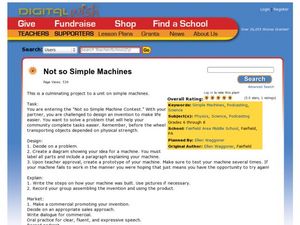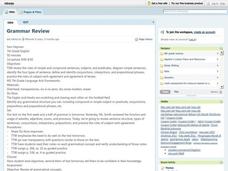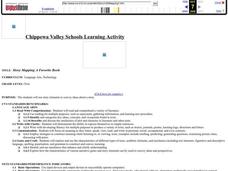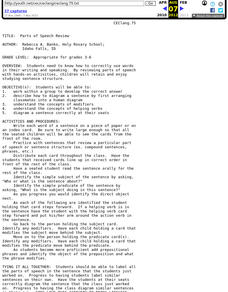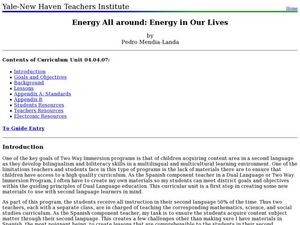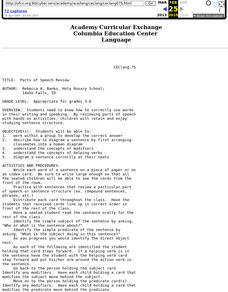Curated OER
Color-Coded Sentence Diagrams
Students read Ruth Heller's books and learn to identify various parts of speech. They label words according to the parts of speech and use the words to form simple and then more complex sentences. Afterward, they analyze sentences and...
Curated OER
Not So Simple Machines
Students design a simple machine for a simple machine contest. In this simple machine lesson, students design a simple machine that will solve a problem. They draw a diagram, label it, and test the machine before they present it in a...
Workforce Solutions
Workforce Solutions K-1 Lessons
Three lessons and one at-home connection explore 12 professions. In the first lesson, scholars examine an online map that displays all 12 careers alongside a video. Lesson two challenges class members to choose two of those careers to...
Curated OER
Grammar Review
Review grammar rules for simple and compound sentences. Learners diagram sentences and identify conjunctions, interjections, and prepositional phrases. As a class, they study their notes and complete pages in their grammar book to...
Curated OER
Miss Nelson Is Missing/Miss Nelson Is Back- Lesson 4
Students compare two stories. In this compare and contrast lesson, students read Miss Nelson is Missing and Miss Nelson is Back. Students brainstorm similarities and differences in the two stories, use a Venn Diagram to...
Curated OER
Story Mapping A Favorite Book
First graders create a diagram of a story by using the computer program Kidspiration. In this diagramming lesson plan, 1st graders will pick a book to write about. They then will plug in story elements of the book into the computer...
Curated OER
Nouns
Young scholars recognize common nouns and proper nouns and use them in proper paragraph form. They get the opportunity to play noun bingo. In addition, diagramming simple and compound noun sentences are undertaken within this lesson.
Curated OER
Parts of Speech Review
Young scholars need to know how to correctly use words in their writing and speaking. By reviewing parts of speech with hands-on activities, students retain and enjoy studying sentence structure.
Curated OER
The Last Word: Using Critical Thinking and Analysis to Reach a Decision
Want to explore the process of writing a persuasive essay and tie it in with the upcoming elections? Class members use Venn diagrams and the hamburger model of persuasive writing to write a five-paragraph essay on elections and...
Curated OER
Charlotte's Web
Fourth graders focus on fluency by reading the book Charlotte's Web. In this reading strategies lesson plan, 4th graders partner read, do guided reading, and independent reading to increase fluency. Students use Venn Diagrams,...
Curated OER
Energy All Around: Energy in Our Lives
Students identify the different sources of energy. For this energy lesson, students list different machines and identify the type of energy used to operate them. They create a diagram of a wind turbine and label its parts.
Curated OER
Seismometer
All this resource provides is a black line diagram of a simple seismometer and two sentences explaining how it works. Use this as a transparency or display it through your projector when studying tectonic activity. It would be especially...
Curated OER
Miss Nelson is Missing / Miss Nelson Is Back- Lesson 2
Young scholars read and analyze a story. In this compare and contrast lesson, students re-read Miss Nelson is Missing and use a Venn Diagram to compare and contrast Miss Nelson and Miss Viola Swamp. Young scholars write about...
Curated OER
Parts of Speech Review
Students practice the parts of speech using index cards to label words in a sentence.
Curated OER
Parts of a Tree
Second graders examine the parts of a tree and their uses. In this tree lesson, 2nd graders view diagrams of tree parts. Students label a blank tree and discuss the use for each part of the tree.
Curated OER
Giving and Taking Directions
Students identify the difference between commands and a declarative sentence. They complete a diagram with verbs, prepositions and numbers. They follow directions using a map and give directions to another location.
Curated OER
Giving and Taking Directions (Middle School)
Students describe the difference between a declarative sentence and a command. They complete a diagram verbs, prepositions and numbers. They follow directions on a map and create directions of their own to another location.
Curated OER
Then and Now
Students explain the differences and time relationships between the past simple, present perfect (continuous) and present simple tenses when speaking about the past and present. They use a graphic organizer before speaking.
Curated OER
What About Health?
Students examine the concepts of healthy and unhealthy drugs. They read and discuss excerpts from the book "The Human Body," develop a list of healthy and unhealthy drugs, and write sentences relating to safety about medicines and other...
Curated OER
The Difference Between Comets, Meteors And Asteroids
Students use Venn diagrams to highlight the similarities and differences between comets, meteors, and asteroids.
Curated OER
Using Non-Text Features
Second graders examine graphs and charts from their local newspaper. As a class, they discuss what the data means and how it relates to the article. In groups, they are shown two sets of graphs or charts and they practice explaining...
Curated OER
The Language of Anatomy
Students review the concept of anatomical directions. In pairs, they label each other according to those directions and label a diagram of themselves with the directions as well. They participate in a game of "Simon Says" to review the...
Curated OER
Lollies, Lollies, Lollies
Students listen to the problem read to them. They answer some simple questions using number sentences. They then compose a written record of the solution and share their approaches used.
Curated OER
Science: Teddy Bear Nation
Students sort teddy bears according to types and then graph the results. They each bring a bear to class and then discuss their similarities and differences. Once the bears have been sorted into groups according to size and color,...

